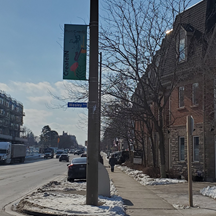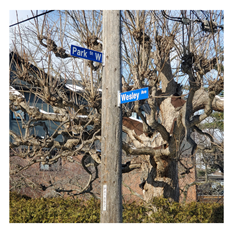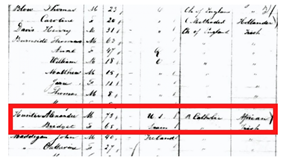The 2023 theme for Black History Month is: “Ours to tell”. This theme represents both an opportunity to engage in open dialogue and a commitment to learning more about the stories Black communities in Canada have to tell about their histories, successes, sacrifices and triumphs.
Heritage Mississauga’s Historian, Matthew Wilkinson, has diligently been exploring and documenting Black History in Mississauga and has identified two historic connections to early Black settlement and current street names in Port Credit and has shared the following stories:
Wesley Avenue (Old Sam’s Lane)
As a port town, Port Credit saw its fair share of people from many different places. Samuel Carter was a fugitive slave, who escaped to Canada. He paid a high price for freedom: during his flight from slavery, he lost both his legs due to the exposure to cold. Little is known of his early years, of his story, or even of his life afterwards in Port Credit. He arrived in Port Credit after 1861 and lived there until his passing in October of 1888. It is not known when or where he was born.
In Port Credit Samuel was befriended by James Shaw (1811-1908), a well-known and respected resident of Port Credit. James secured a horse for Samuel, along with some sort of lift that allowed Samuel to get on the horse. Samuel, and using the horse to pull a small wagon, Samuel assisted in transporting people to Sunday service at First Methodist Church.
Samuel lived in a small cabin near the Methodist Manse on a tree-lined dirt laneway that was locally known as “Old Sam’s Lane”. The lane was eventually widened, paved and renamed “Wesley Avenue” – either in reference to the presence of the Wesleyan Methodist Manse or for a local resident, Wesley Watson.
as “Old Sam’s Lane”. The lane was eventually widened, paved and renamed “Wesley Avenue” – either in reference to the presence of the Wesleyan Methodist Manse or for a local resident, Wesley Watson.
Samuel was apparently well-loved in Port Credit. When he fell ill in the fall of 1887, town residents banded together to make sure he was looked after. Port Credit Council on at least one occasion made money available for Samuel, and in early 1888 Council passed this resolution:
“Moved by Mr. Jackson, and seconded by Mr. Price that the Petition of B.B. Lynd and 22 others be received and that Mr. Lynd and Mr. Oliphant be instructed to have Samuel Carter removed to some place of comfort and have his wants attended to for the present time.”
When Samuel Carter died in October of 1888, Port Credit Council looked after internment expenses. There are no known pictures of Samuel Carter or of his cabin on “Old Sam’s Lane”.
Dr. Ben
Every community has its stories of colourful or beloved “characters” who, in one way of another, connect with the residents of the place. One such story is that of “Dr. Ben” in Port Credit. “Dr. Ben” was described as a “white-headed old negro who lived in a cottage with his white-headed wife” in Port Credit. “Dr. Ben” said that he had been born in Africa, where he was captured and sold into slavery, was sent to Virginia, and escaped to Canada in the late 1840s. Very little is known for certain, although there are some clues.
There is reference to short stub of Park Street West, as it runs west of Wesley Avenue in Port Credit today, as locally being called “Ben’s Lane”. We do not know who the “Ben” was in reference to, but given its proximity to Wesley Avenue (originally known as “Old Sam’s Lane” in reference to Samuel Carter, another former slave), the reference to “Ben’s Lane” is intriguing.
 It is likely that “Dr. Ben” was Benjamin Workman (c1810-1885), who appeared on the area census from 1851 until 1881. Benjamin Workman was listed as negro, born in the United States, a farm labourer by profession, and Methodist in religion. Benjamin and his wife, Hannah, were married in Virginia c1828. However we have no specific information on their escape from slavery and arrival in Canada, other than census records that show they were residents of Port Credit.
It is likely that “Dr. Ben” was Benjamin Workman (c1810-1885), who appeared on the area census from 1851 until 1881. Benjamin Workman was listed as negro, born in the United States, a farm labourer by profession, and Methodist in religion. Benjamin and his wife, Hannah, were married in Virginia c1828. However we have no specific information on their escape from slavery and arrival in Canada, other than census records that show they were residents of Port Credit.
The Workmans are listed as living in a small log cabin, and that they worked on farms for the Madigan, Thomas and Greeniaus families nearby. It is not known if Benjamin and Hannah had any children, although there are no children listed in the census. There are no known images of Benjamin and Hannah Workman or of their log cabin.
Alexander Hunter
Using census records, Justine Lyn Research Assistant at Heritage Mississauga, identified fragments of the story of Alexander Hunter.
 Alexander Hunter was a resident of Port Credit, listed as being of African heritage. He was married to a white, Irish woman, named Bridget, and together they lived in a three-room shack on the bank of the credit river, adjacent to what is now Riverside School. He worked as a labourer for James Robinson Shaw, a local grocer.
Alexander Hunter was a resident of Port Credit, listed as being of African heritage. He was married to a white, Irish woman, named Bridget, and together they lived in a three-room shack on the bank of the credit river, adjacent to what is now Riverside School. He worked as a labourer for James Robinson Shaw, a local grocer.
Alexander Hunter likely died sometime in 1887 or 1888 when he was roughly 80 years old.
Hunter is mentioned in the Toronto Township Council minutes from 1887: “Resolved- that the petition of James R. Shaw and 32 others in reference to Alexander Hunter and wife that the Reeve be instructed to have them placed in the house of Providence or some other public institution.
If our Port Credit community wishes to explore Black History further, we encourage you to take a look at the following resources:
Recommended Reading:
A Forgotten Past: Early Black History in Mississauga
https://www.yumpu.com/en/document/read/63451043/a-forgotten-past-early-black-history-in-mississauga
The Grange: The Legend of Cedar Park:
https://heritagemississauga.com/wp-content/uploads/2020/02/The-Grange-Volume-8-final-for-web.pdf
Black Heritage Matters Webinar series:
Courageous Conversations: Connecting Black History to 2022 with Rosemary Sadlier OOnt:
https://youtu.be/WRlUhVdR3Qc
Why Black History is Important with Lezlie Harper: https://youtu.be/3HfVOr0bLbI
Thank you to Heritage Mississauga for their ongoing efforts to explore Black History in Mississauga and for sharing their resources celebrating the incredible history that we continue to see on the landscape of Port Credit today.



 as “Old Sam’s Lane”. The lane was eventually widened, paved and renamed “Wesley Avenue” – either in reference to the presence of the Wesleyan Methodist Manse or for a local resident, Wesley Watson.
as “Old Sam’s Lane”. The lane was eventually widened, paved and renamed “Wesley Avenue” – either in reference to the presence of the Wesleyan Methodist Manse or for a local resident, Wesley Watson. It is likely that “Dr. Ben” was Benjamin Workman (c1810-1885), who appeared on the area census from 1851 until 1881. Benjamin Workman was listed as negro, born in the United States, a farm labourer by profession, and Methodist in religion. Benjamin and his wife, Hannah, were married in Virginia c1828. However we have no specific information on their escape from slavery and arrival in Canada, other than census records that show they were residents of Port Credit.
It is likely that “Dr. Ben” was Benjamin Workman (c1810-1885), who appeared on the area census from 1851 until 1881. Benjamin Workman was listed as negro, born in the United States, a farm labourer by profession, and Methodist in religion. Benjamin and his wife, Hannah, were married in Virginia c1828. However we have no specific information on their escape from slavery and arrival in Canada, other than census records that show they were residents of Port Credit. Alexander Hunter was a resident of Port Credit, listed as being of African heritage. He was married to a white, Irish woman, named Bridget, and together they lived in a three-room shack on the bank of the credit river, adjacent to what is now Riverside School. He worked as a labourer for James Robinson Shaw, a local grocer.
Alexander Hunter was a resident of Port Credit, listed as being of African heritage. He was married to a white, Irish woman, named Bridget, and together they lived in a three-room shack on the bank of the credit river, adjacent to what is now Riverside School. He worked as a labourer for James Robinson Shaw, a local grocer.

